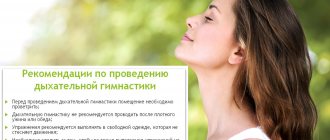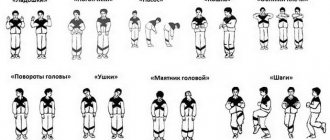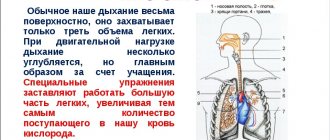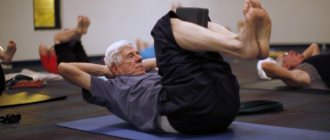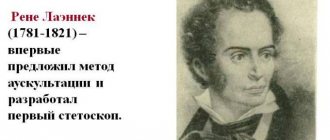Is it possible to do physical exercise?
For angina pectoris, physical therapy is one of the methods of therapy, since it promotes the following processes:
- normalization of vascular reactions during muscular work;
- eliminating spasms in the cardiovascular system;
- improving the functioning of the excretory system.
At the same time, it is important to choose physical activity wisely so as not to worsen your well-being. It depends on the stage of the disease, which can be:
- Initial . The person experiences only slight discomfort, attacks occur very rarely and do not last long. It is recommended to exercise for no more than 30 minutes. The exercises can be quite intense. They help improve the functions of internal organs and develop all muscle groups.
- Typical . The patient experiences attacks during various physical activities. Pain can occur when climbing stairs, walking for a long time, as well as during stress and emotional overstrain. His general condition worsens, shortness of breath appears, and his heart rate increases. You can train for up to 20 minutes, but you must strictly monitor your heart rate. Perform exercises in a less strenuous mode, be sure to take breaks between them, during which to restore breathing and pulse.
- Pronounced . A person experiences pain even in a state of complete rest. You should avoid active activities and prolonged exercise. However, even at this stage it is allowed to perform physical therapy exercises. Classes last no longer than 15 minutes (they also include 5 minutes for a break between exercises). Do the exercises at a calm pace. If an attack develops, dizziness or shortness of breath occurs, you should immediately stop exercising and consult a doctor.
Basic rules of exercise therapy
When practicing physical therapy, it is important to adhere to the basic rules, which look like this:
- conduct classes 2–8 days after the attack, depending on its severity;
- start training with minimal load and duration;
- when exercising, listen carefully to the body and, if your health condition worsens, interrupt the complex, and if necessary, consult a doctor to adjust physical therapy;
- combine active exercises with breathing exercises.
Exercise sets
Cardiologists have developed special complexes, which can be found below. Before performing them, you need to consult with your doctor, who can supplement or replace some exercises, increase or decrease the duration of exercises.
Warm-up
The lesson always begins with a warm-up. Its task is to prepare the body for further stress and “warm up” the muscles. Repeat each exercise 3-4 times:
- Stand straight, feet shoulder-width apart. Tilt the body left and right, back and forth at a calm pace. Look straight ahead.
- Raise your arms above your head to your sides. Stand on your toes and reach for the sky, and then return to the starting position.
- Starting position - lying on your back, legs and arms spread apart, but without much tension. Bend and straighten your fingers alternately on the lower and upper limbs.
- Lie on your back. Move your toes forward and backward.
Complex No. 1
Perform the exercises 4-5 times, and the starting position does not change - lying on your back:
- Pull your shoulders up, trying to reach the tips of your ears with them. Perform the exercise slowly without effort, monitoring your breathing.
- Bend your legs at the knees and bend your arms at the elbows. Take turns to carefully describe a circle with them.
- Extend your arms along your body, palms down, and bend your legs at the knees. Leaning on your legs, raise your buttocks and stomach as much as possible, forming a triangle. The main load falls on the legs and arms.
- Bend your legs at the knees and spread them in different directions, connecting your feet.
- Finally, walk in place. For the first time, the walking duration should not exceed 1 minute. Then, with the doctor's permission, it can be gradually increased.
Complex No. 2
Suitable for those who suffer from stable angina. Consists of the following exercises:
- Starting position: sitting on a chair, arms down and relaxed. Extend your arms to the sides to shoulder level, take a deep breath and exhale. Repeat 5 times.
- The starting position is similar, but the hands are located at the waist. Raise one arm over the side to shoulder level, inhale, return to the starting position and exhale. Do the same with the other hand. Repeat 3 times for each hand.
- The starting position is standing, feet shoulder-width apart, arms bent horizontally at the elbow joint and fixed in front of the chest. Make body turns with arms raised - inhale, return to the starting position - exhale. Repeat 4 times.
- Finish by walking in place for 60 seconds.
Therapeutic gymnastics exercises for coronary heart disease
Coronary heart disease (CHD) is a serious disease that requires immediate treatment.
Very often, one dose of medication is not enough for a complete recovery, so the attending physician prescribes his patients a specialized set of exercises that will help improve the patient’s well-being and overcome the disease - therapeutic exercises for coronary artery disease. During exercise, blood circulation is normalized, the respiratory and cardiovascular systems return to normal.
It is important that doing gymnastics for coronary heart disease helps cope with stress, emotional experiences and strengthen the body. With correctly selected and dosed exercises, you can significantly improve your health.
Features of the classes
Ischemia can manifest itself in several well-known forms: angina pectoris and myocardial infarction; it is accompanied by chest pain, which is caused by vascular spasms and periodic attacks.
This disease is very dangerous, so if you feel pain in the heart area or discomfort during physical activity, you should immediately consult a doctor.
Only an experienced specialist will choose the optimal way out of the situation.
Each patient tolerates physical activity differently, so before starting to exercise on your own, a diagnosis from a professional is required. Only a doctor can prescribe specialized exercises for you based on your predisposition to exercise.
There are 4 types of patients: the first two are better adapted to stress, they rarely have attacks. The third and fourth types should be extremely careful with exercise therapy, since any careless movement can result in complications.
It is important for patients with coronary artery disease not to overexert themselves, as this can cause an exacerbation of the disease. Exercise in the intervals between attacks in a comfortable environment and in good health, so as not to harm the body.
If you feel the slightest discomfort, immediately stop performing the complex to avoid complications. At the initial stage, do not take on too much.
Don’t worry that you can’t do all the exercises at once; over time, your physical fitness will improve and your heart muscle will get stronger, making it easier for you to exercise.
Training
This list is an approximate set of exercises, the regular implementation of which will help cope with coronary heart disease. All exercises are arranged in increasing order of severity.
It is recommended to start with the very basics and then move on to more complex ones. At the very beginning, breathing exercises for angina pectoris will help.
The basic rules for implementation are control of breathing, gradual implementation of all actions and tracking of all sensations and processes that can be observed in the body.
You should start with simple exercises performed while sitting:
- Sitting on a chair, lower your arms down and relax your shoulders, keeping your back straight. Slowly raise your arms to the sides, reach shoulder level, and take a deep breath. Next, slowly, lower them to their original position and exhale. We perform from 3 to 5 repetitions.
- The starting position does not change, we keep our hands on the waist. Next, we raise one hand up to the side and take a slow breath. Then we lower it and exhale. We do 3-5 repetitions.
- We intertwine our hands into a “lock”, turn our palms out and raise them in front of us to shoulder level, taking a smooth breath. Then we lower them down and place them in the “lock” position on our knees. 6-7 repetitions are enough.
- We stretch our legs: we lean on a chair, leave one leg under the chair, put the other forward and lift it slightly. Let's watch our breathing. We alternate legs 8-10 times.
After this complex does not cause any difficulties, you can proceed to standing exercises:
- We stand up and slightly spread our legs to the sides, tilt our heads to the sides 2-3 times in each direction and smoothly move on to rotations in a circle: 2-3 circles with our heads clockwise and the same amount counterclockwise.
- Maintaining the position of the legs, we rotate the elbows 4-5 times forward and the same number of times backward. We rotate slowly, but carefully work the shoulder joints (with slight muscle tension possible).
- Feet shoulder-width apart, arms bent at the elbows and held at chest level. Gently turn your body to the sides, opening your arms. When turning around we inhale, when returning we exhale. Repeat 5 times in each direction.
- We press our hands to the body, bend to the sides, smoothly sliding the hand along the leg. We perform 4-5 times in each direction.
- Legs slightly apart, hands resting on the back of the chair. We do squats as deep as possible. Attention, this exercise should be performed carefully if you have knee joint disease.
If you have back and joint pain, do the exercises carefully with a small amplitude. If any unpleasant sensations arise, stop performing it.
Mode
Once you have mastered all of the above, you will be ready to move on to the next stage. For patients suffering from an acute form of coronary heart disease, it is recommended to stop here, since further exercises will follow that are not suitable for everyone.
You should start by simply walking around the room. Carefully and slowly, we walk around the room for 30 seconds. Then we begin walking with high hip lifts also for 30 seconds. We gradually increase the time, the main thing is that you feel comfortable.
Short walks outside are also useful: you not only warm up and tone your muscles, but also breathe fresh air. A simple walk for 20 minutes will be an excellent activity for ischemia.
Only after you have become accustomed to walking for long periods of time should you pick up your pace and walk at a faster pace. Walking with ski poles is ideal: they help with the work of the arms.
Jogging is recommended only for patients of the first and second types who tolerate light physical activity well. Any activity increases fitness, which means resistance to the stress of the heart muscle.
Exercise therapy for angina and ischemia is a very effective method to help overcome the disease. However, to solve the problem, it is necessary to act comprehensively, from all sides. Visit your doctor regularly and follow your medication regimen. Compliance with this regimen will ease the course of the disease, reduce the frequency of attacks and the severity of pain.
Consult your doctor about nutrition. It is not necessary to adhere to some very strict diet; it is enough to eat a balanced and healthy diet. Remember that microelements such as magnesium, potassium, and iodine affect the health of the heart and blood vessels. Do not eat fatty, smoked, or overly salty products.
Eating apples, pomegranates, cereals, beets, pumpkins, and a decoction of rose hips will be beneficial.
The main thing is to never give up and not lose faith in your own strength: to keep the body healthy for many years, it is enough to exercise moderately, strengthen the body, monitor nutrition, maintain a cheerful mood and consult a doctor in time to diagnose and cure the disease.
Coronary heart disease and gymnastics are compatible if done carefully and under the supervision of a doctor. Therefore, be sure to consult your doctor before exercising.
Source: //gimnastikasport.ru/lechebnaya/lfk/ishemicheskaja-bolezn-serdsa.html
Breathing exercises
In tandem with physical therapy, breathing exercises give good results, because when performed, the organs are enriched with oxygen, the heartbeat and metabolism are stabilized, the diaphragm is strengthened, and the emotional state and well-being improve.
For angina pectoris, it is recommended to do breathing exercises using the Buteyko method. The Soviet physiologist and clinician believed that with this disease a person breathes shallowly and with difficulty. Such unusual breathing for the body leads to the fact that the lungs quickly contract and the blood vessels narrow. As a result, there is an excessive accumulation of carbon dioxide in the blood, and the body experiences oxygen starvation.
The breathing pattern is as follows:
- inhale - 5 seconds;
- exhale - 5 seconds;
- pause with maximum relaxation - 5 seconds.
How can you tell if you're breathing correctly? Place one hand on your stomach and the other on your chest. If, when inhaling, the stomach is first drawn in, and then the chest, then the exercise is performed correctly. It should be remembered that you inhale through your nose and exhale through your mouth.
Contraindications to breathing exercises:
- pregnancy and lactation;
- chronic diseases;
- inflammatory diseases of the small and large pelvis;
- adenomyosis.
Features of exercise therapy for ischemia
Gymnastics for coronary heart disease faces 8 main tasks:
- Put the central and autonomic nervous system in order.
- Eliminate muscle imbalances.
- Stimulate metabolism by increasing redox reactions and energy expenditure.
- Normalize carbohydrate and fat metabolism.
- Improve the general condition of the cardiovascular system through:
- normalization of coronary and peripheral blood flow;
- increasing the contractile function of the myocardium;
- creating the necessary tone in the vessels;
- activation of the blood anticoagulant system.
Increase the efficiency of external respiration due to:
- increased mobility of the diaphragm, sternum, vertebral joints, muscle strength of the respiratory system;
- increasing the surface of the lungs;
- creating a network of complete ventilation-perfusion relationships.
Bring the activity of the gastrointestinal tract back to normal, preventing splanchnoptosis and the occurrence of cardiac hernias, as motility and secretions begin to work better.
Increase the vital functions of the body and its tolerance to physical activity.
Gymnastics for coronary heart disease is selected taking into account the current functionality of the patient’s cardiovascular system and his ability to engage in physical exercise. To do this, load tests are carried out using a bicycle ergometer and/or treadmill. In this case, heart rate at the threshold load will be the basis for calculating heart rate readings during gymnastic exercises. The training pulse can be:
- maximum - 50-80% of the threshold value;
- minimum - 80-85%.
The peculiarity of assessing the patient’s condition is to undergo special tests, of which there are quite a few. So, K. Cooper tested patients by the maximum distance they could cover in 12 minutes. Then their health is assessed from excellent to very poor.
The benefits of physical activity for cardiac ischemia
For physical rehabilitation, doctors prescribe light exercises at the very beginning of the post-infarction period. The purpose of such exercises is to restore breathing and bring the patient out of a serious condition.
It must be remembered that therapeutic exercises for ischemic heart disease are prescribed strictly by a specialist. Excessive physical activity and too intense exercise can negatively affect your health and lead to a relapse of the attack.
Regular physical activity is beneficial for everyone. For healthy people, it helps prevent the onset of diseases, and for those who have already suffered heart disease, physical education reduces the recovery period and prevents the development of relapse.
Physical activity for coronary artery disease helps:
- keep muscles toned;
- reduce the level of atherogenic lipids in the blood (cholesterol, low-density lipoprotein, etc.), thereby reducing the risk of atherosclerosis;
- normalize blood pressure;
- prevent the formation of blood clots;
- improve quality of life, improve mood;
- normalize sleep;
- prevent obesity and reduce the risk of diabetes.
According to medical research, people who engage in physical therapy after a heart attack are 7 times less likely to suffer a recurrence of such a heart attack and reduce the likelihood of death by 6 times. Exercise therapy for coronary heart disease can improve the general health of the patient. Regular exercise improves blood flow, minimizes the effects of heart failure, and strengthens the cardiovascular system.
Indications and contraindications
Exercises for cardiac ischemia are prescribed to patients divided into groups:
- with angina pectoris;
- after myocardial infarction and/or with acquired cardiosclerosis;
- with a left ventricular aneurysm, which resulted in myocardial infarction.
Training is selected taking into account the degree of pathology:
- at initial insufficiency of the coronary system there are no symptoms;
- in a typical case, the clinical picture does not appear until the patient begins to increase physical activity or suffers emotional stress;
- with pronounced clinical manifestations of the pathology are present even at rest.
Do not forget about the contraindications of exercise therapy for ischemic heart disease:
- frequent angina pectoris;
- there are acute disorders in the coronary circulation;
- failure from the first stage and above;
- persistent rhythm disturbance;
- cardiac aneurysm.
In this case, exercise therapy can be prescribed in the intervals between attacks of angina:
- mild attack - you can start on the second day after it;
- severe case - day 8;
- elderly people after a moderate attack - on the 4th day.
Rules for performing exercises
Both at home and in the hospital, the patient must adhere to the following rules when engaging in exercise therapy:
- If the patient belongs to the first group, then the duration of his training can be 30-45 minutes.
- For the second group, you cannot load all the muscles in one workout with a duration of no more than a quarter of an hour.
- After breathing exercises, be sure to rest.
- Constantly monitor your pulse, the permissible deviation is 10% from the norm.
- For the third group, exercises are very limited, as they can provoke thromboembolism. It is permissible to train individual muscle groups with partial amplitudes, and the training should not take more than 10 minutes.
- If your health worsens, for example, patients with hypertension may experience shortness of breath or heart pain, classes should be stopped immediately.
- It doesn’t matter whether a child or an adult has suffered from coronary artery disease, the doctor will select all the exercises while still in the hospital and give recommendations regarding home exercises.
Physiotherapy for ischemic heart disease
Physiotherapeutic procedures are very important during the recovery period. They are selected by a physiotherapist.
Balneotherapy involves taking therapeutic baths - radon, carbon dioxide, iodine-bromine, chloride. There may be contraindications to such a procedure, such as pain, persistent angina, arrhythmia, and hypertension. If the patient has more severe angina, then a gentle method is used in the form of four-chamber baths.
Electrosleep, galvanic collar, electrophoresis with painkillers and sedatives are also used. Recently, a new method of physiotherapy has appeared - laser treatment.
Rehabilitation should take place gradually and only under the supervision of a doctor. Coronary heart disease and angina pectoris can only recede if you follow all the recommendations and take care of your body.
Standard set of therapeutic exercises
The goal of any exercise therapy for coronary artery disease is to make the patient more resilient and improve his well-being. In a hospital, a specialist deals with the patient, but at home you need to do everything yourself, focusing on medical recommendations.
With a specialist
This complex consists of the following exercises:
- Lie on your back using a flat floor. Spread your arms and legs to the sides. Start with the folds of your fingers, then on your toes. Then do both at the same time. Breathing is calm, the body is completely relaxed. You need 6 approaches.
- From the same position, begin to perform breathing exercises, starting with deep breaths in and out, which should be from 3 to 5.
- Now spread your legs and turn them so that your toes are turned inward and outward. Watch your breathing so that it doesn't come true.
- From a lying position, you need to raise your shoulders and inhale, exhaling and lie down again. You need to do 3 approaches.
- From the initial pose, bend your arms and legs. Do rotational circular movements at least 6 times, while maintaining a moderate pace.
- Now bend your knees and lift your pelvis, exhaling, and lower as you inhale. Three approaches.
- Now you need to spread your knees to the sides. Do it either slowly or at a medium pace. Inhale - knees to the sides, exhale - together.
It is recommended to exercise at least 3 times every 7 days. If the cardiogram improves, the frequency of approaches can be increased to 10.
In just 2 weeks of such gymnastics, it is possible to move on to more complex exercises, such as lateral turns and climbing stairs without the help of others.
The shoulder and hip joints begin to work better. You can use a ball and a stick for training, and do coordination exercises.
Important! A lot of walking is now harmful, no more than 100 steps per day is acceptable!
After lying down exercises there is a smooth transition to sitting and standing. During the rehabilitation period, many exercises will need to be done at home. In the hospital, with significant improvements, you will need to walk more, on average 2-3 km per day.
An approximate set of exercises in the post-infarction state in the first period
Exercises alternate with breathing exercises:
- Lying on the floor, arms and legs apart, you should alternately bend your fingers and toes. After several such exercises, move on to simultaneously bending your fingers and toes. Breathing should be even. Everything is done slowly up to 6 times.
- Lying in the same way, arms and legs apart, perform breathing exercises. Inhale freely, then exhale. Repeat 3 times.
- From the same position, the legs are spread apart, the exercise is done with the toes, first they are moved apart to the outside, then they are turned inward. The pace of this exercise is average, breathing is even.
- In the same position, raise your shoulders - inhale, lower them - exhale. Repeat 3 times. Breathing is even.
- Lying in the starting position, raise your arms at the elbows and legs at the knees, make circular movements with your hand from the elbow and legs from the knee. In the first days, the arms and legs do the exercise alternately, later everything is done simultaneously with the arms and legs. Such actions are carried out 2-6 times. The tempo is a little more intense than slow. Breathing is even.
- The body position is the same, legs bent at the knees, lift the hip joint off the floor and inhale, lower - exhale. Repeat 3 times. Breathing is not impaired.
- Lying down, bend your legs at the knees and alternately lower them to the right and then to the left. Each tilt is done 2 times. Breathing is slow, the pace of exercise is average.
- Lying in the same position, spread your knees in different directions - inhale, close them - exhale. Repeat 2-3 times, exercise pace is average.
Gymnastics are performed for up to 20 minutes on average 3-4 times a day. If the cardiogram gives good results, then over time it will be possible to increase such exercises up to 10 times a day.
On days 10-16 of physical therapy, you can move on to the next stage, when a person can already turn onto his right side and climb stairs independently. The development of motor functions begins. This is done so that the heart rhythm is not disturbed, shortness of breath and heart pain do not appear. Light exercises are performed to teach the patient to sit, stand up, climb stairs, etc.
Classes are aimed at working large and medium-sized joints - shoulder and hip. A stick and a rubber ball are used. Exercises are aimed at coordination of movements, balance and attention. Walking should include from 10 to 100 steps. In this case, you should rest often.
Physical therapy is done in a sitting or standing position. One breathing exercise is performed every two special exercises. Time: 40 minutes a day, 3-4 times.
After a person begins to move independently, the third period of rehabilitation and physical therapy begins. At this time, the cardiovascular system and breathing are trained. The emphasis is on walking. Initially, it is carried out on a flat surface, later it is worth making descents and ascents. Initially, you should walk up to 500 m, and rest every 5 minutes. You should get 60 steps per minute. Every day the distance should be increased by 100-200 m and so brought to a kilometer.
In the future, under the supervision of a doctor, you can take walks of up to 2 km. These classes are conducted in a clinic or sanatorium.
After exercise therapy for coronary artery disease within a medical institution has ended, it is necessary to continue exercising at home. In this case, you should undergo an examination 2 times a month.
Only after a year can you do more complex types of gymnastics and other exercises, skiing, cycling or visiting gyms. But this should only be done with the permission of a doctor.
It is worth remembering that physical activity should be distributed evenly.
The benefits of breathing exercises for the heart
If you observe a person who is under stress or experiencing an attack of heart pain, then rapid and shallow breathing will be noticed in everyone. Since our body works on the principle of feedback, slowing down and deepening breathing can have a healing effect on many organs. Even simple fixation on an even rhythm and awareness of the duration of the breathing cycle is used in meditative practices.
The positive effect of breathing exercises is manifested in this way:
- the blood and muscle fibers of the heart are saturated with oxygen;
- with deep breathing, the cavities of the heart are better filled with blood and are released from it during contraction;
- when holding your breath, an artificial oxygen deficiency is created, which dilates the cerebral and coronary vessels;
- the rhythm of contractions is normalized;
- the balance between the processes of excitation and inhibition in the cerebral cortex is restored.
Breathing exercises are effective for preventing congestion in the lungs. It is recommended in the early recovery period after a heart attack and cardiac surgery. Sometimes this is the only type of activity available to the patient.
We recommend reading the article about exercises for the heart. From it you will learn about physical activity and basic rules for training, useful exercises for the heart muscle.
And here is more information about exercises for arrhythmia.
Useful exercises to strengthen the myocardium
In diseases of the cardiovascular system, it is the loads that can increase the resistance of the myocardium to oxygen starvation that bring benefits. These include walking, running, swimming, dancing. Breathing exercises have a similar effect on the heart muscle. Methods for carrying it out may differ, but the most important rule is that the exercises must be performed at an individual, comfortable level.
First aid for arrhythmia
The method of restoring heart rhythm using breathing is based on the fact that a measured rhythm of inhalation and exhalation, which a person can control, normalizes the rhythm of contractions of the heart muscle. Therefore, any option with counting the duration of respiratory movements helps with arrhythmia.
To do this, you can inhale for 2 - 3 counts and exhale for 4 - 6 counts. In this case, you need to be in a sitting position with a straight back. It is recommended to gradually stretch your inhalations and exhalations, focusing on your sensations.
After mastering this exercise, the following type of pulmonary exercises is recommended to prevent attacks:
- Left hand behind back.
- The right hand is located near the face.
- Close your right nostril with your right thumb.
- Inhale through the left nostril.
- Close the left nostril with your ring finger and exhale through the right nostril.
After 8 - 10 breathing cycles, you need to change hands. The duration of the first lesson should not exceed 2 - 3 minutes, then you can slowly increase it. The duration of inhalations and exhalations is determined by comfortable sensations.
For cardiac aneurysm
The use of any load for training, even breathing, with an aortic or cerebral aneurysm, is possible only after consulting a doctor, since stress can provoke intense internal bleeding and death.
Breathing exercises for angina pectoris
breathing exercises for angina
I suffered greatly from angina pectoris (angina pectoris), the most common form of coronary heart disease. Its main manifestation is attacks of squeezing, pressing pain in the chest. Angina occurs suddenly, lasts from several minutes to half an hour, has varying intensity, and can radiate to the left arm, shoulder blade, shoulder or neck. An angina attack is often accompanied by a feeling of fear. Do not give in to it and try to immediately relieve the heartache. To do this, always have validol on hand. If an angina attack occurs while walking, and there is no validol, you should immediately stop, relax and breathe evenly. Soon the pain will subside.
After another treatment in the hospital, the attending physician told me: “That’s it, now you won’t be able to live without nitroglycerin.”
But despite the verdict, I decided not to give up, began to read various publications on medical topics, apply the recommended methods for treating angina pectoris, and eventually settled on breathing exercises according to the yoga system.
To breathe correctly using this method, you need to stand or sit on a chair with a straight back, relax, think about something pleasant (I always think about the sea), inhale air through your nose and hold it in your chest so that it feels comfortable. Exhale through your mouth and, at the same time as you exhale, lightly hit your chest with your arms bent at the elbows, like wings, to the left and right. Perform this breathing for 10 minutes, first once a day, and after a week - in the morning, at lunch and in the evening.
I breathed this way for a month, then took a 10-day break, and after that I repeated the treatment course. And so she was treated intermittently for six months. During this exercise, when you hold your breath, oxygen is directly sent to the heart muscle, relieving tension. You need to be careful at first to avoid dizziness. Perform yoga breathing exercises until complete recovery. You yourself must feel when the angina attacks stop, since each person is individual. After this, undergo a medical examination.
In addition to performing breathing exercises for angina pectoris, it is necessary to walk daily in the fresh air near a pond, in a forest or park, inhaling fresh air enriched with oxygen.
It’s very good to do this with someone so that while walking you can have a conversation and get positive emotions.
After recovery, stress should be avoided, as it can lead to relapse of the disease. One day, having already recovered, I ran to catch up with the trolleybus (there was such a need) and suddenly I felt that I wouldn’t make it. Immediately, according to the yoga system, I inhaled air through my nose, held my breath, and thus solved the stressful situation - the trolleybus did not leave without me.
It is very important to learn to forgive everyone, constantly wish people health, goodness, and not remember grievances (mentally burn them in fire). Do not harbor anger, since most diseases are the result of negative thoughts, deeds and emotions. You can't live in the past, you have to live in the future.
Smile more, laugh, have fun, dance, listen to music and remember that all our organs need to be treated only with good thoughts and that everyone can be their own healer. You can and should talk to each organ affectionately, as if you were talking to a part of yourself.
For example, if your heart hurts or tachycardia occurs, immediately place your right palm under your left chest on the heart area, close your eyes, think about this organ with gratitude that it has selflessly served you for so many years and thanks to it you live, and mentally to calm your heart , say: “Everything is fine, calm down. The heart beats rhythmically. I am surrounded by nature, the elements: sun, air, water, earth. I live in harmony with my organs, including the most important organ - the heart. Calm down, dear, we will live together in harmony for a long time.” Gently stroke the area, pressing your hand tightly to your chest, using light circular movements so that your palm moves slowly, always in a clockwise direction. Say a kind word to your heart, wish it good luck and end your communication with the words: “So be it. Amen!"
Even the ancients considered the heart to be the center of reason, love and selflessness. Take care of him!
Ivanova Valentina Nikolaevna
What is aortic stenosis?
Aortic stenosis is a narrowing of the aorta, the largest artery that connects to the left ventricle of the heart, through which oxygenated blood flows to supply the body with oxygen and nutrients. The most common cause of aortic stenosis is congenital - the defect is already present at birth. However, rheumatic fever can also cause aortic stenosis, and aging is associated with. ⇒
How to keep your heart healthy?
Although health ministers are trying to convince us that in a few years we will forget about cardiovascular diseases, this is hard to believe. Why? Yes, because half of the country's population has cholesterol levels above normal levels - these are middle-aged people. And for those who are in favor. ⇒
Antihypertensive and antiarrhythmic drugs in the treatment of cardiovascular diseases
Those drugs that affect the blood itself, the blood vessels and heart muscle, can also be used to treat cardiovascular diseases. These drugs change heart rate and blood pressure, the pumping function of the heart, and blood clotting and flow. Antihypertensive drugs and medications Antihypertensive drugs are used to treat high blood pressure. (hypertension). Their. ⇒
20 tips to protect yourself from stress
Stress creeps up unnoticed - minor problems, irritation and dissatisfaction with life accumulate little by little and soon overflow. You can continue to be in a state of permanent stress, destroying your health, or you can slightly adjust your usual behavior and make life more cloudless! Before you is a whole arsenal of simple but effective ways how. ⇒
Materials used in the article:
https://gimnastikasport.ru/lechebnaya/lfk/ishemicheskaja-bolezn-serdsa.html
https://med-akademiya.ru/dyxatelnye-uprazhneniya-pri-stenokardii/
https://serdce.biz/simptomy/bolit-serdce-chto-delat-v-domashnih-usloviyah.html
Post Views: 66
